6 Environments
Your deck is now ready for a game of blackjack (or hearts or war), but are your shuffle() and deal() functions up to snuff? Definitely not. For example, deal() deals the same card over and over again:
deal(deck)
## face suit value
## king spades 13
deal(deck)
## face suit value
## king spades 13
deal(deck)
## face suit value
## king spades 13And the shuffle() function doesn’t actually shuffle deck (it returns a copy of deck that has been shuffled). In short, both of these functions use deck, but neither manipulates deck—and we would like them to.
To fix these functions, you will need to learn how R stores, looks up, and manipulates objects like deck. R does all of these things with the help of an environment system.
6.1 Environments
Consider for a moment how your computer stores files. Every file is saved in a folder, and each folder is saved in another folder, which forms a hierarchical file system. If your computer wants to open up a file, it must first look up the file in this file system.
You can see your file system by opening a finder window. For example, Figure 6.1 shows part of the file system on my computer. I have tons of folders. Inside one of them is a subfolder named Documents, inside of that subfolder is a sub-subfolder named ggsubplot, inside of that folder is a folder named inst, inside of that is a folder named doc, and inside of that is a file named manual.pdf.
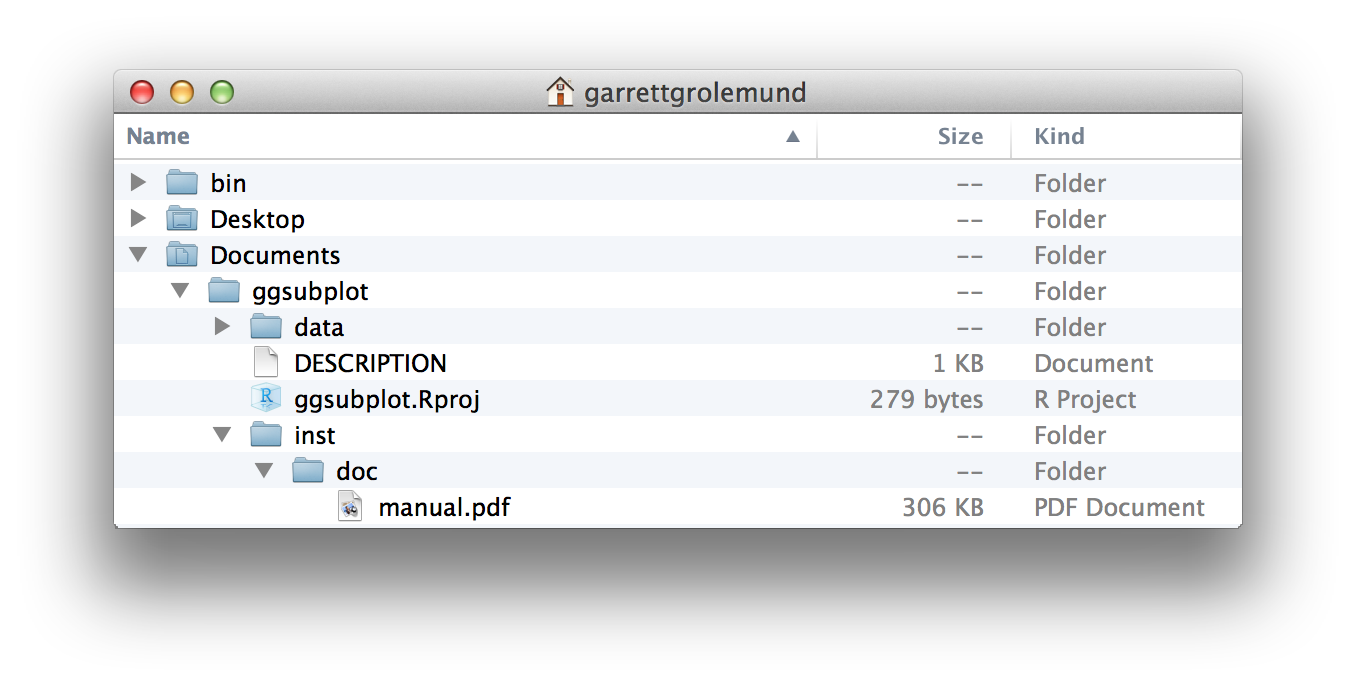
R uses a similar system to save R objects. Each object is saved inside of an environment, a list-like object that resembles a folder on your computer. Each environment is connected to a parent environment, a higher-level environment, which creates a hierarchy of environments.
You can see R’s environment system with the parenvs() function in the pryr package (note parenvs() came in the pryr package when this book was first published). parenvs(all = TRUE) will return a list of the environments that your R session is using. The actual output will vary from session to session depending on which packages you have loaded. Here’s the output from my current session:
library(pryr)
parenvs(all = TRUE)
## label name
## 1 <environment: R_GlobalEnv> ""
## 2 <environment: package:pryr> "package:pryr"
## 3 <environment: 0x7fff3321c388> "tools:rstudio"
## 4 <environment: package:stats> "package:stats"
## 5 <environment: package:graphics> "package:graphics"
## 6 <environment: package:grDevices> "package:grDevices"
## 7 <environment: package:utils> "package:utils"
## 8 <environment: package:datasets> "package:datasets"
## 9 <environment: package:methods> "package:methods"
## 10 <environment: 0x7fff3193dab0> "Autoloads"
## 11 <environment: base> ""
## 12 <environment: R_EmptyEnv> "" It takes some imagination to interpret this output, so let’s visualize the environments as a system of folders, Figure 6.2. You can think of the environment tree like this. The lowest-level environment is named R_GlobalEnv and is saved inside an environment named package:pryr, which is saved inside the environment named 0x7fff3321c388, and so on, until you get to the final, highest-level environment, R_EmptyEnv. R_EmptyEnv is the only R environment that does not have a parent environment.

Remember that this example is just a metaphor. R’s environments exist in your RAM memory, and not in your file system. Also, R environments aren’t technically saved inside one another. Each environment is connected to a parent environment, which makes it easy to search up R’s environment tree. But this connection is one-way: there’s no way to look at one environment and tell what its “children” are. So you cannot search down R’s environment tree. In other ways, though, R’s environment system works similar to a file system.
6.2 Working with Environments
R comes with some helper functions that you can use to explore your environment tree. First, you can refer to any of the environments in your tree with as.environment(). as.environment() takes an environment name (as a character string) and returns the corresponding environment:
as.environment("package:stats")
## <environment: package:stats>
## attr(,"name")
## [1] "package:stats"
## attr(,"path")
## [1] "/Library/Frameworks/R.framework/Versions/3.0/Resources/library/stats"Three environments in your tree also come with their own accessor functions. These are the global environment (R_GlobalEnv), the base environment (base), and the empty environment (R_EmptyEnv). You can refer to them with:
globalenv()
## <environment: R_GlobalEnv>
baseenv()
## <environment: base>
emptyenv()
##<environment: R_EmptyEnv>Next, you can look up an environment’s parent with parent.env():
parent.env(globalenv())
## <environment: package:pryr>
## attr(,"name")
## [1] "package:pryr"
## attr(,"path")
## [1] "/Library/Frameworks/R.framework/Versions/3.0/Resources/library/pryr"Notice that the empty environment is the only R environment without a parent:
parent.env(emptyenv())
## Error in parent.env(emptyenv()) : the empty environment has no parentYou can view the objects saved in an environment with ls() or ls.str(). ls() will return just the object names, but ls.str() will display a little about each object’s structure:
ls(emptyenv())
## character(0)
ls(globalenv())
## "deal" "deck" "deck2" "deck3" "deck4" "deck5"
## "die" "gender" "hand" "lst" "mat" "mil"
## "new" "now" "shuffle" "vec" The empty environment is—not surprisingly—empty; the base environment has too many objects to list here; and the global environment has some familiar faces. It is where R has saved all of the objects that you’ve created so far.
RStudio’s environment pane displays all of the objects in your global environment.
You can use R’s $ syntax to access an object in a specific environment. For example, you can access deck from the global environment:
head(globalenv()$deck, 3)
## face suit value
## king spades 13
## queen spades 12
## jack spades 11And you can use the assign() function to save an object into a particular environment. First give assign() the name of the new object (as a character string). Then give assign() the value of the new object, and finally the environment to save the object in:
assign("new", "Hello Global", envir = globalenv())
globalenv()$new
## "Hello Global"Notice that assign() works similar to <-. If an object already exists with the given name in the given environment, assign() will overwrite it without asking for permission. This makes assign() useful for updating objects but creates the potential for heartache.
Now that you can explore R’s environment tree, let’s examine how R uses it. R works closely with the environment tree to look up objects, store objects, and evaluate functions. How R does each of these tasks will depend on the current active environment.
6.2.1 The Active Environment
At any moment of time, R is working closely with a single environment. R will store new objects in this environment (if you create any), and R will use this environment as a starting point to look up existing objects (if you call any). I’ll call this special environment the active environment. The active environment is usually the global environment, but this may change when you run a function.
You can use environment() to see the current active environment:
environment()
<environment: R_GlobalEnv>The global environment plays a special role in R. It is the active environment for every command that you run at the command line. As a result, any object that you create at the command line will be saved in the global environment. You can think of the global environment as your user workspace.
When you call an object at the command line, R will look for it first in the global environment. But what if the object is not there? In that case, R will follow a series of rules to look up the object.
6.3 Scoping Rules
R follows a special set of rules to look up objects. These rules are known as R’s scoping rules, and you’ve already met a couple of them:
- R looks for objects in the current active environment.
- When you work at the command line, the active environment is the global environment. Hence, R looks up objects that you call at the command line in the global environment.
Here is a third rule that explains how R finds objects that are not in the active environment
- When R does not find an object in an environment, R looks in the environment’s parent environment, then the parent of the parent, and so on, until R finds the object or reaches the empty environment.
So, if you call an object at the command line, R will look for it in the global environment. If R can’t find it there, R will look in the parent of the global environment, and then the parent of the parent, and so on, working its way up the environment tree until it finds the object, as in Figure 6.3. If R cannot find the object in any environment, it will return an error that says the object is not found.
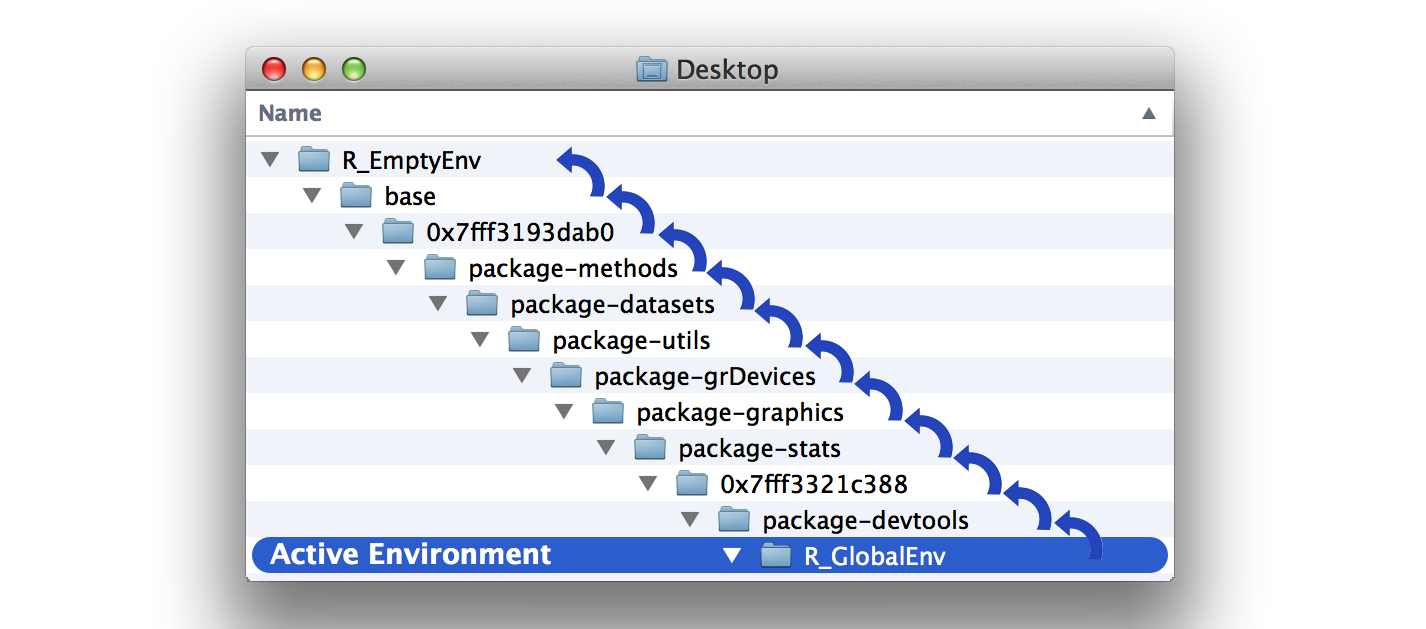
Remember that functions are a type of object in R. R will store and look up functions the same way it stores and looks up other objects, by searching for them by name in the environment tree.
6.4 Assignment
When you assign a value to an object, R saves the value in the active environment under the object’s name. If an object with the same name already exists in the active environment, R will overwrite it.
For example, an object named new exists in the global environment:
new
## "Hello Global"You can save a new object named new to the global environment with this command. R will overwrite the old object as a result:
new <- "Hello Active"
new
## "Hello Active"This arrangement creates a quandary for R whenever R runs a function. Many functions save temporary objects that help them do their jobs. For example, the roll() function from Project 1: Weighted Dice saved an object named die and an object named dice:
roll <- function() {
die <- 1:6
dice <- sample(die, size = 2, replace = TRUE)
sum(dice)
}R must save these temporary objects in the active environment; but if R does that, it may overwrite existing objects. Function authors cannot guess ahead of time which names may already exist in your active environment. How does R avoid this risk? Every time R runs a function, it creates a new active environment to evaluate the function in.
6.5 Evaluation
R creates a new environment each time it evaluates a function. R will use the new environment as the active environment while it runs the function, and then R will return to the environment that you called the function from, bringing the function’s result with it. Let’s call these new environments runtime environments because R creates them at runtime to evaluate functions.
We’ll use the following function to explore R’s runtime environments. We want to know what the environments look like: what are their parent environments, and what objects do they contain? show_env() is designed to tell us:
show_env <- function(){
list(ran.in = environment(),
parent = parent.env(environment()),
objects = ls.str(environment()))
}show_env() is itself a function, so when we call show_env(), R will create a runtime environment to evaluate the function in. The results of show_env() will tell us the name of the runtime environment, its parent, and which objects the runtime environment contains:
show_env()
## $ran.in
## <environment: 0x7ff711d12e28>
##
## $parent
## <environment: R_GlobalEnv>
##
## $objectsThe results reveal that R created a new environment named 0x7ff711d12e28 to run show_env() in. The environment had no objects in it, and its parent was the global environment. So for purposes of running show_env(), R’s environment tree looked like Figure 6.4.
Let’s run show_env() again:
show_env()
## $ran.in
## <environment: 0x7ff715f49808>
##
## $parent
## <environment: R_GlobalEnv>
##
## $objectsThis time show_env() ran in a new environment, 0x7ff715f49808. R creates a new environment each time you run a function. The 0x7ff715f49808 environment looks exactly the same as 0x7ff711d12e28. It is empty and has the same global environment as its parent.
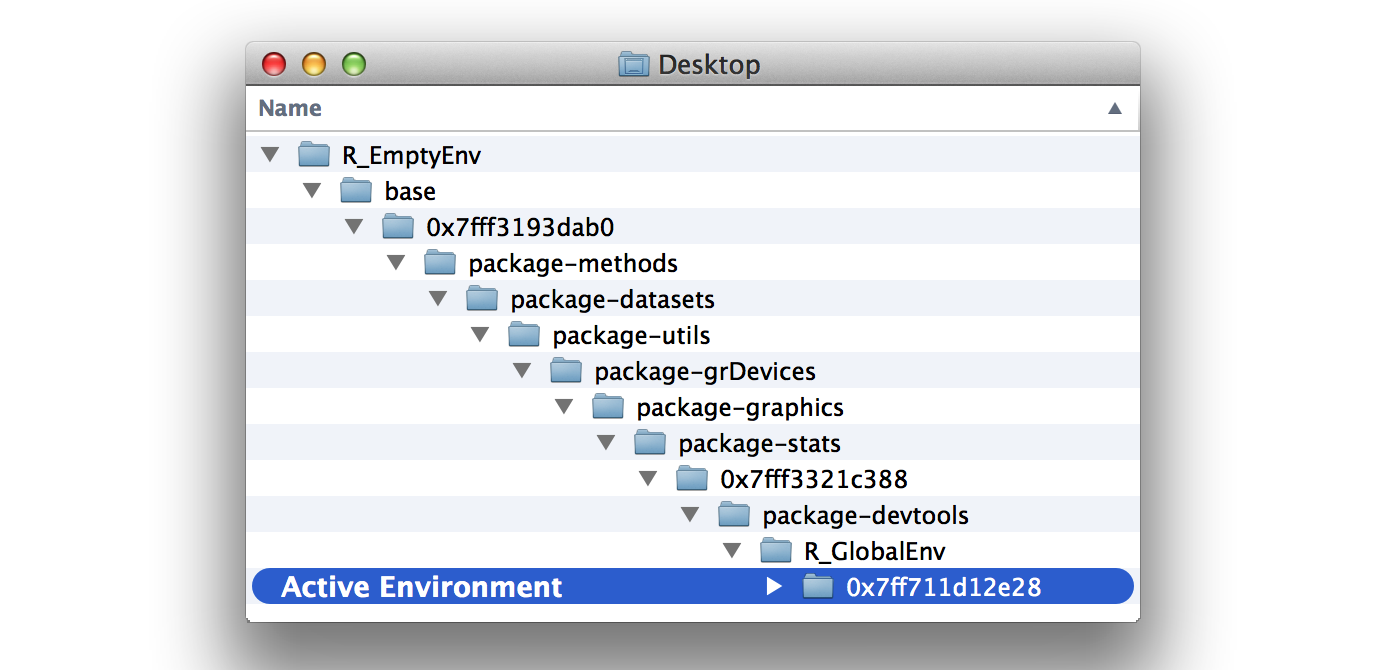
Now let’s consider which environment R will use as the parent of the runtime environment.
R will connect a function’s runtime environment to the environment that the function was first created in. This environment plays an important role in the function’s life—because all of the function’s runtime environments will use it as a parent. Let’s call this environment the origin environment. You can look up a function’s origin environment by running environment() on the function:
environment(show_env)
## <environment: R_GlobalEnv>The origin environment of show_env() is the global environment because we created show_env() at the command line, but the origin environment does not need to be the global environment. For example, the environment of parenvs() is the pryr package:
environment(parenvs)
## <environment: namespace:pryr>In other words, the parent of a runtime environment will not always be the global environment; it will be whichever environment the function was first created in.
Finally, let’s look at the objects contained in a runtime environment. At the moment, show_env()’s runtime environments do not contain any objects, but that is easy to fix. Just have show_env() create some objects in its body of code. R will store any objects created by show_env() in its runtime environment. Why? Because the runtime environment will be the active environment when those objects are created:
show_env <- function(){
a <- 1
b <- 2
c <- 3
list(ran.in = environment(),
parent = parent.env(environment()),
objects = ls.str(environment()))
}This time when we run show_env(), R stores a, b, and c in the runtime environment:
show_env()
## $ran.in
## <environment: 0x7ff712312cd0>
##
## $parent
## <environment: R_GlobalEnv>
##
## $objects
## a : num 1
## b : num 2
## c : num 3This is how R ensures that a function does not overwrite anything that it shouldn’t. Any objects created by the function are stored in a safe, out-of-the-way runtime environment.
R will also put a second type of object in a runtime environment. If a function has arguments, R will copy over each argument to the runtime environment. The argument will appear as an object that has the name of the argument but the value of whatever input the user provided for the argument. This ensures that a function will be able to find and use each of its arguments:
foo <- "take me to your runtime"
show_env <- function(x = foo){
list(ran.in = environment(),
parent = parent.env(environment()),
objects = ls.str(environment()))
}
show_env()
## $ran.in
## <environment: 0x7ff712398958>
##
## $parent
## <environment: R_GlobalEnv>
##
## $objects
## x : chr "take me to your runtime"Let’s put this all together to see how R evaluates a function. Before you call a function, R is working in an active environment; let’s call this the calling environment. It is the environment R calls the function from.
Then you call the function. R responds by setting up a new runtime environment. This environment will be a child of the function’s origin environment. R will copy each of the function’s arguments into the runtime environment and then make the runtime environment the new active environment.
Next, R runs the code in the body of the function. If the code creates any objects, R stores them in the active, that is, runtime environment. If the code calls any objects, R uses its scoping rules to look them up. R will search the runtime environment, then the parent of the runtime environment (which will be the origin environment), then the parent of the origin environment, and so on. Notice that the calling environment might not be on the search path. Usually, a function will only call its arguments, which R can find in the active runtime environment.
Finally, R finishes running the function. It switches the active environment back to the calling environment. Now R executes any other commands in the line of code that called the function. So if you save the result of the function to an object with <-, the new object will be stored in the calling environment.
To recap, R stores its objects in an environment system. At any moment of time, R is working closely with a single active environment. It stores new objects in this environment, and it uses the environment as a starting point when it searches for existing objects. R’s active environment is usually the global environment, but R will adjust the active environment to do things like run functions in a safe manner.
How can you use this knowledge to fix the deal() and shuffle() functions?
First, let’s start with a warm-up question. Suppose I redefine deal() at the command line like this:
deal <- function() {
deck[1, ]
}Notice that deal() no longer takes an argument, and it calls the deck object, which lives in the global environment.
Yes. deal() will still work the same as before. R will run deal() in a runtime environment that is a child of the global environment. Why will it be a child of the global environment? Because the global environment is the origin environment of deal() (we defined deal() in the global environment):
environment(deal)
## <environment: R_GlobalEnv>When deal() calls deck, R will need to look up the deck object. R’s scoping rules will lead it to the version of deck in the global environment, as in Figure 6.5. deal() works as expected as a result:
deal()
## face suit value
## king spades 13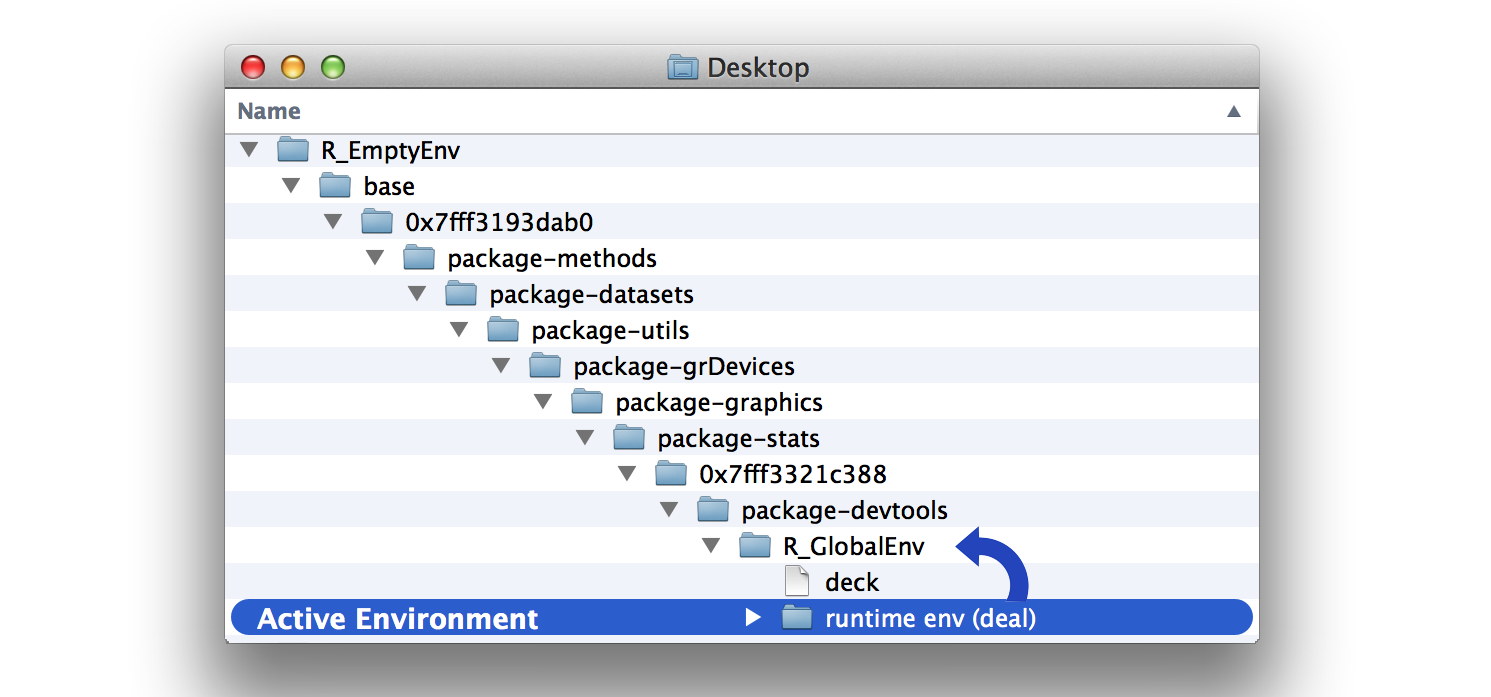
deck by looking in the parent of deal’s runtime environment. The parent is the global environment, deal’s origin environment. Here, R finds the copy of deck.Now let’s fix the deal() function to remove the cards it has dealt from deck. Recall that deal() returns the top card of deck but does not remove the card from the deck. As a result, deal() always returns the same card:
deal()
## face suit value
## king spades 13
deal()
## face suit value
## king spades 13You know enough R syntax to remove the top card of deck. The following code will save a prisitine copy of deck and then remove the top card:
DECK <- deck
deck <- deck[-1, ]
head(deck, 3)
## face suit value
## queen spades 12
## jack spades 11
## ten spades 10Now let’s add the code to deal(). Here deal() saves (and then returns) the top card of deck. In between, it removes the card from deck…or does it?
deal <- function() {
card <- deck[1, ]
deck <- deck[-1, ]
card
}This code won’t work because R will be in a runtime environment when it executes deck <- deck[-1, ]. Instead of overwriting the global copy of deck with deck[-1, ], deal() will just create a slightly altered copy of deck in its runtime environment, as in Figure 6.6.
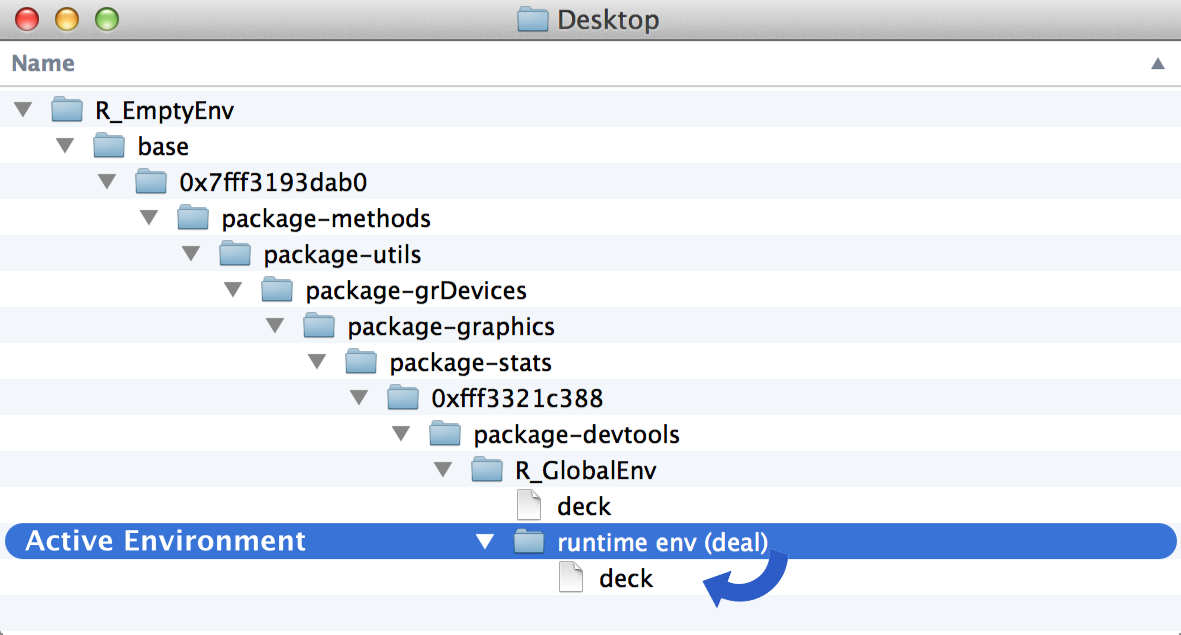
deck[-1, ] in the runtime environment as a new object named deck.You can assign an object to a specific environment with the assign() function:
deal <- function() {
card <- deck[1, ]
assign("deck", deck[-1, ], envir = globalenv())
card
}Now deal() will finally clean up the global copy of deck, and we can deal() cards just as we would in real life:
deal()
## face suit value
## queen spades 12
deal()
## face suit value
## jack spades 11
deal()
## face suit value
## ten spades 10Let’s turn our attention to the shuffle() function:
shuffle <- function(cards) {
random <- sample(1:52, size = 52)
cards[random, ]
}shuffle(deck) doesn’t shuffle the deck object; it returns a shuffled copy of the deck object:
head(deck, 3)
## face suit value
## nine spades 9
## eight spades 8
## seven spades 7
a <- shuffle(deck)
head(deck, 3)
## face suit value
## nine spades 9
## eight spades 8
## seven spades 7
head(a, 3)
## face suit value
## ace diamonds 1
## seven clubs 7
## two clubs 2This behavior is now undesirable in two ways. First, shuffle() fails to shuffle deck. Second, shuffle() returns a copy of deck, which may be missing the cards that have been dealt away. It would be better if shuffle() returned the dealt cards to the deck and then shuffled. This is what happens when you shuffle a deck of cards in real life.
You can update shuffle() in the same way that you updated deck. The following version will do the job:
shuffle <- function(){
random <- sample(1:52, size = 52)
assign("deck", DECK[random, ], envir = globalenv())
}Since DECK lives in the global environment, shuffle()’s environment of origin, shuffle() will be able to find DECK at runtime. R will search for DECK first in shuffle()’s runtime environment, and then in shuffle()’s origin environment—the global environment—which is where DECK is stored.
The second line of shuffle() will create a reordered copy of DECK and save it as deck in the global environment. This will overwrite the previous, nonshuffled version of deck.
6.6 Closures
Our system finally works. For example, you can shuffle the cards and then deal a hand of blackjack:
shuffle()
deal()
## face suit value
## queen hearts 12
deal()
## face suit value
## eight hearts 8But the system requires deck and DECK to exist in the global environment. Lots of things happen in this environment, and it is possible that deck may get modified or erased by accident.
It would be better if we could store deck in a safe, out-of-the-way place, like one of those safe, out-of-the-way environments that R creates to run functions in. In fact, storing deck in a runtime environment is not such a bad idea.
You could create a function that takes deck as an argument and saves a copy of deck as DECK. The function could also save its own copies of deal() and shuffle():
setup <- function(deck) {
DECK <- deck
DEAL <- function() {
card <- deck[1, ]
assign("deck", deck[-1, ], envir = globalenv())
card
}
SHUFFLE <- function(){
random <- sample(1:52, size = 52)
assign("deck", DECK[random, ], envir = globalenv())
}
}When you run setup(), R will create a runtime environment to store these objects in. The environment will look like Figure 6.7.
Now all of these things are safely out of the way in a child of the global environment. That makes them safe but hard to use. Let’s ask setup() to return DEAL and SHUFFLE so we can use them. The best way to do this is to return the functions as a list:
setup <- function(deck) {
DECK <- deck
DEAL <- function() {
card <- deck[1, ]
assign("deck", deck[-1, ], envir = globalenv())
card
}
SHUFFLE <- function(){
random <- sample(1:52, size = 52)
assign("deck", DECK[random, ], envir = globalenv())
}
list(deal = DEAL, shuffle = SHUFFLE)
}
cards <- setup(deck)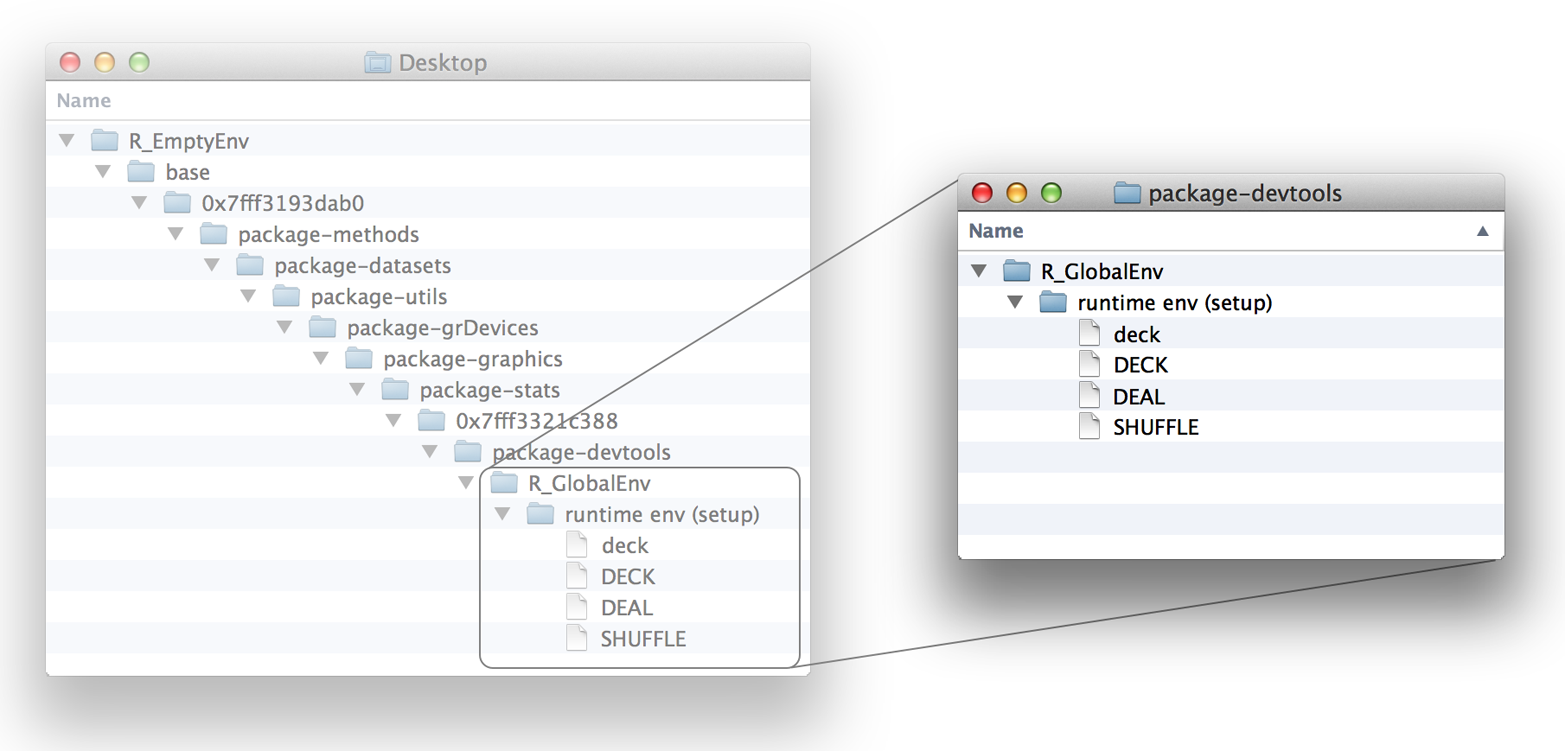
Then you can save each of the elements of the list to a dedicated object in the global environment:
deal <- cards$deal
shuffle <- cards$shuffleNow you can run deal() and shuffle() just as before. Each object contains the same code as the original deal() and shuffle():
deal
## function() {
## card <- deck[1, ]
## assign("deck", deck[-1, ], envir = globalenv())
## card
## }
## <environment: 0x7ff7169c3390>
shuffle
## function(){
## random <- sample(1:52, size = 52)
## assign("deck", DECK[random, ], envir = globalenv())
## }
## <environment: 0x7ff7169c3390>However, the functions now have one important difference. Their origin environment is no longer the global environment (although deal() and shuffle() are currently saved there). Their origin environment is the runtime environment that R made when you ran setup(). That’s where R created DEAL and SHUFFLE, the functions copied into the new deal() and shuffle(), as shown in:
environment(deal)
## <environment: 0x7ff7169c3390>
environment(shuffle)
## <environment: 0x7ff7169c3390>Why does this matter? Because now when you run deal() or shuffle(), R will evaluate the functions in a runtime environment that uses 0x7ff7169c3390 as its parent. DECK and deck will be in this parent environment, which means that deal() and shuffle() will be able to find them at runtime. DECK and deck will be in the functions’ search path but still out of the way in every other respect, as shown in Figure 6.8.
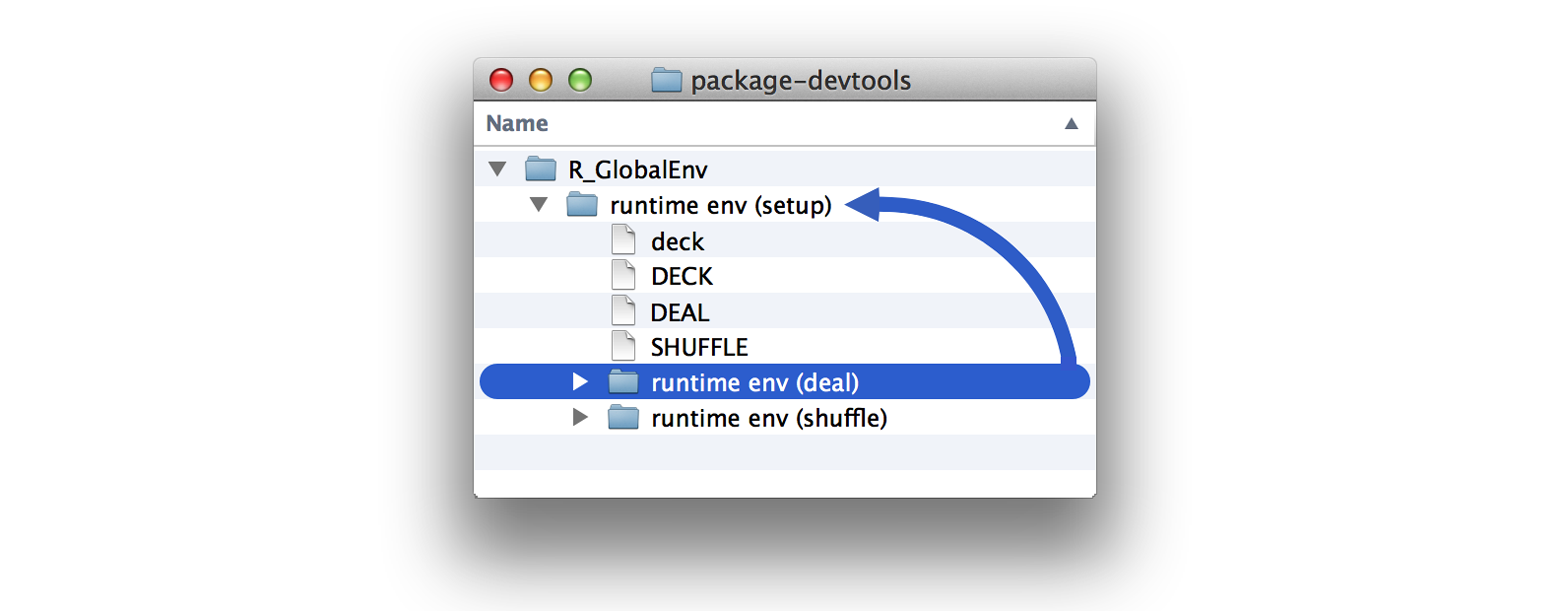
This arrangement is called a closure. setup()’s runtime environment “encloses” the deal() and shuffle() functions. Both deal() and shuffle() can work closely with the objects contained in the enclosing environment, but almost nothing else can. The enclosing environment is not on the search path for any other R function or environment.
You may have noticed that deal() and shuffle() still update the deck object in the global environment. Don’t worry, we’re about to change that. We want deal() and shuffle() to work exclusively with the objects in the parent (enclosing) environment of their runtime environments. Instead of having each function reference the global environment to update deck, you can have them reference their parent environment at runtime, as shown in Figure 6.9:
setup <- function(deck) {
DECK <- deck
DEAL <- function() {
card <- deck[1, ]
assign("deck", deck[-1, ], envir = parent.env(environment()))
card
}
SHUFFLE <- function(){
random <- sample(1:52, size = 52)
assign("deck", DECK[random, ], envir = parent.env(environment()))
}
list(deal = DEAL, shuffle = SHUFFLE)
}
cards <- setup(deck)
deal <- cards$deal
shuffle <- cards$shuffle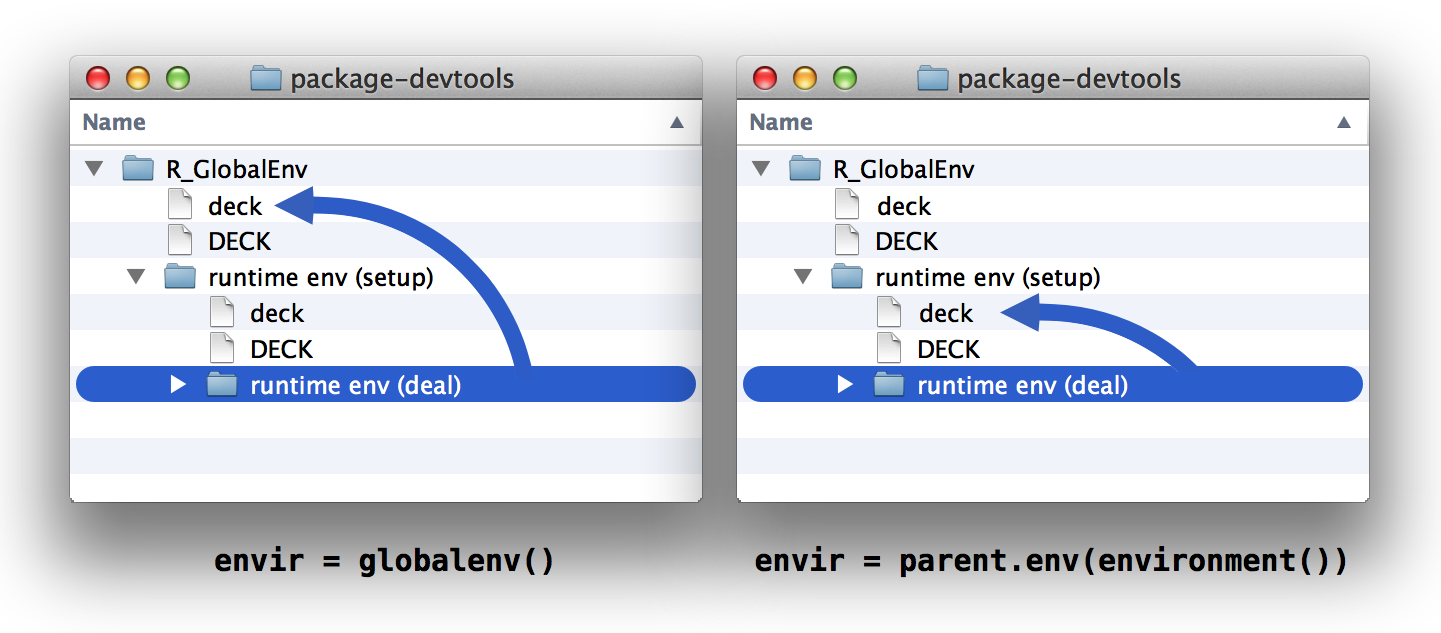
We finally have a self-contained card game. You can delete (or modify) the global copy of deck as much as you want and still play cards. deal() and shuffle() will use the pristine, protected copy of deck:
rm(deck)
shuffle()
deal()
## face suit value
## ace hearts 1
deal()
## face suit value
## jack clubs 11Blackjack!
6.7 Summary
R saves its objects in an environment system that resembles your computer’s file system. If you understand this system, you can predict how R will look up objects. If you call an object at the command line, R will look for the object in the global environment and then the parents of the global environment, working its way up the environment tree one environment at a time.
R will use a slightly different search path when you call an object from inside of a function. When you run a function, R creates a new environment to execute commands in. This environment will be a child of the environment where the function was originally defined. This may be the global environment, but it also may not be. You can use this behavior to create closures, which are functions linked to objects in protected environments.
As you become familiar with R’s environment system, you can use it to produce elegant results, like we did here. However, the real value of understanding the environment system comes from knowing how R functions do their job. You can use this knowledge to figure out what is going wrong when a function does not perform as expected.
6.8 Project 2 Wrap-up
You now have full control over the data sets and values that you load into R. You can store data as R objects, you can retrieve and manipulate data values at will, and you can even predict how R will store and look up your objects in your computer’s memory.
You may not realize it yet, but your expertise makes you a powerful, computer-augmented data user. You can use R to save and work with larger data sets than you could otherwise handle. So far we’ve only worked with deck, a small data set; but you can use the same techniques to work with any data set that fits in your computer’s memory.
However, storing data is not the only logistical task that you will face as a data scientist. You will often want to do tasks with your data that are so complex or repetitive that they are difficult to do without a computer. Some of the things can be done with functions that already exist in R and its packages, but others cannot. You will be the most versatile as a data scientist if you can write your own programs for computers to follow. R can help you do this. When you are ready, Project 3: Slot Machine will teach you the most useful skills for writing programs in R.